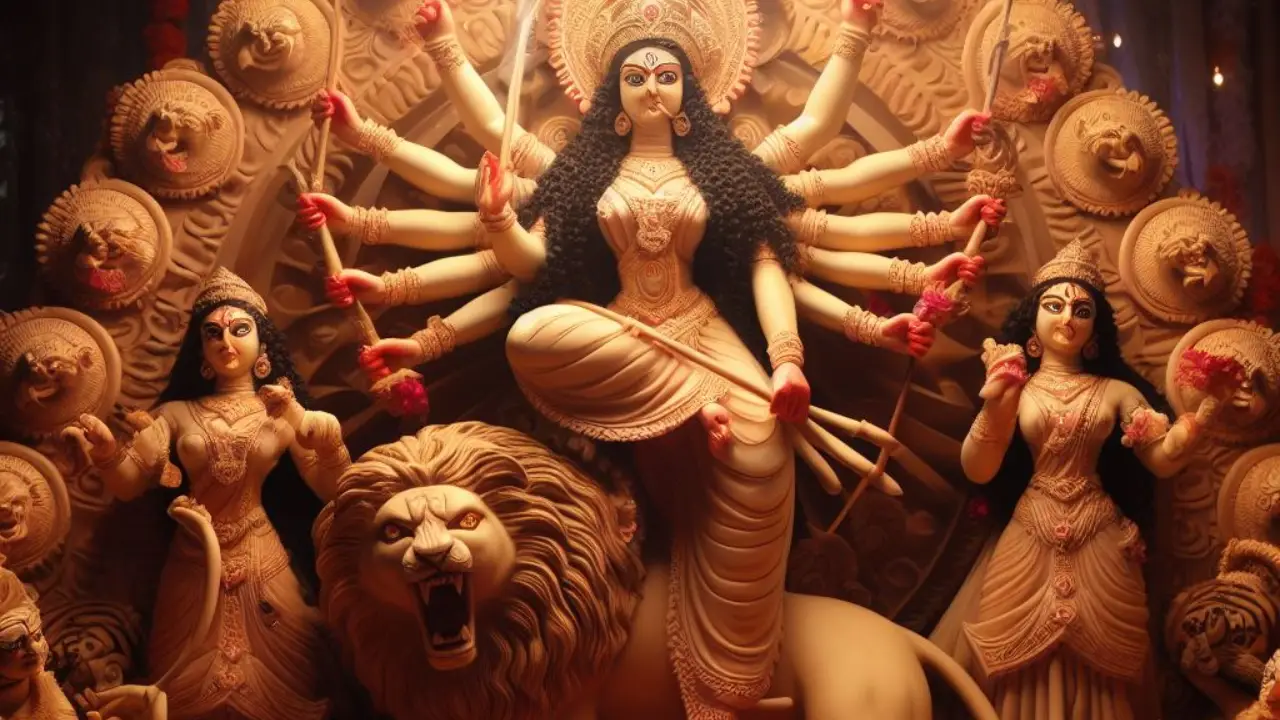Navratri, the 9 nights of fervent devotion and celebration, holds a special place in the hearts of millions of Hindus worldwide. During this festival, we pay homage to the 9 Forms of Maa Durga, who symbolizes power, protection, and divine energy. Navratri is not just about fasting and dancing; it’s a profound spiritual journey that brings us closer to the various forms of Maa Durga. Let’s dive into the divine realms of these 9 avatars.
Day 1. Shailaputri – The Daughter of the Mountains: Embodiment of Nature’s Purity
Shailaputri, often called ‘Parvati’ or ‘Hemavati,’ is the daughter of King Himalaya. She left her royal abode to embrace a life of asceticism and purity. Her name, ‘Shailaputri,’ literally translates to ‘Daughter of the Mountains,’ signifying her earthly and elemental essence. Riding a bull, she symbolizes steadfastness and the ability to endure the harshest of circumstances.
As we worship Shailaputri, we are reminded of the importance of connecting with the Earth, respecting its resources, and understanding that true strength lies in perseverance and an unshakable spirit.
Day 2. Brahmacharini – The Devotee of Lord Shiva: A Beacon of Devotion and Knowledge
Brahmacharini, the second form of Maa Durga, is known for her unwavering devotion and dedication to Lord Shiva. She represents the pursuit of knowledge, spirituality, and self-discipline. Holding a mala (rosary) and a kamandalu (water pot), she reflects the virtues of restraint and wisdom.
Through the worship of Brahmacharini, we are reminded of the significance of knowledge, the value of self-discipline, and the rewards of a devoted heart on the spiritual path.
Day 3. Chandraghanta – The Warrior Goddess: The Fierce Guardian of Goodness
Chandraghanta is one of the fiercest forms of Maa Durga. She derives her name from the crescent moon adorning her forehead and the shape of her bell (ghanta). Riding a tiger, she embodies courage and fearlessness, protecting her devotees from all adversities.
Chandraghanta reminds us that bravery and inner strength are essential attributes in our journey through life. She teaches us to confront our fears and challenges with unwavering determination.
Day 4. Kushmanda – The Creator of the Universe: The Radiant Source of Life
Kushmanda, the fourth form of the 9 forms of Maa Durga, is the creator of the universe. She is often depicted with eight or ten hands, each holding a different symbol of power. Her radiant smile signifies the warmth and light she brought to the universe, akin to the radiant sun.
Worshipping Kushmanda invokes the energy of creation and reminds us of the infinite potential within us to create and bring light into the world.
Day 5. Skandamata – The Mother of Skanda: Love and Compassion Personified
Skandamata, the mother of Lord Kartikeya (Skanda), signifies motherly love and compassion. She holds her son on her lap, emphasizing the profound bond between a mother and her child. Her depiction fosters feelings of warmth, protection, and love.
Through Skandamata, we understand the unparalleled significance of nurturing and love in our lives. She teaches us to appreciate and value the emotional connections that enrich our existence.
Day 6. Katyayani – The Warrior of Love: The Champion of Righteousness
Katyayani, born to Sage Katyayana, is a fierce warrior and champion of righteousness. She carries a sword symbolizing the courage to combat evil and stand up for what is just. Her fearless nature inspires us to fight against the injustices that prevail in the world.
Katyayani reminds us that love, when combined with courage and a sense of justice, can conquer all adversities, allowing us to embrace righteousness in all aspects of life.
Day 7. Kalratri – The Dark Goddess of Time: Dispelling Ignorance and Obstacles
Kalratri, the seventh form of the 9 forms of Maa Durga, is often considered one of the most ferocious. She has a dark complexion and a garland of skulls, signifying her role as the eliminator of ignorance and the remover of obstacles.
As we worship Kalratri, we learn that sometimes, it’s necessary to confront the darkness within and around us to move towards enlightenment. She teaches us to dispel ignorance and face life’s challenges with tenacity and fearlessness.
Day 8. Mahagauri – The Pure Goddess: A Beacon of Purity and Wisdom
Mahagauri, celebrated on the eighth day of Navratri, embodies purity and wisdom. Her white attire symbolizes the light of forgiveness and knowledge. Mahagauri encourages us to seek wisdom and purity in our thoughts and actions.
Worshipping Mahagauri cleanses the soul, fosters clarity of mind, and leads us towards inner serenity and enlightenment.
Day 9. Siddhidatri – The Granter of Desires: Bestower of Wisdom and Fulfillment
Siddhidatri, the ninth and final form of Maa Durga, is the granter of desires and the bestower of wisdom. She sits on a lotus, holding a mace, a conch, and a book. Each of these symbols represents her power to grant spiritual and material wishes and the ability to bestow knowledge and wisdom upon her devotees.
Siddhidatri reminds us that true fulfillment comes not only from the material desires we possess but also from the wisdom we accumulate and the spiritual growth we achieve in our journey through life.
As we honor these 9 forms of Maa Durga during Navratri, we are not only celebrating their divine presence but also imbibing the profound teachings and wisdom they offer, making our lives more meaningful and spiritually enriched.
Now that we’ve explored the divine 9 forms of Maa Durga in detail, we invite you to share your Navratri experiences. How do you connect with these goddesses, and what traditions and rituals do you follow during this auspicious time? Your stories and insights can enrich our understanding of this sacred festival. Please feel free to share your thoughts in the comments below.

